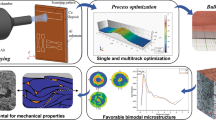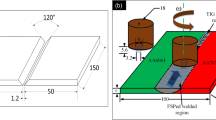Abstract
The effects of activating fluxes on weld bead morphology, arc behavior, electrical signals, and temperature field were investigated. Real-time weld pool dynamics, electrical signal waveforms, and temperature contours were obtained by high speed camera, real-time electric signal acquisition card, and infrared thermal camera. The additions of SiO2, TiO2, ZnO, and Fe2O3 not only improved the weld formation and penetration depth but also reduced the welding voltage and increased welding current. Decomposition and evaporation of activating fluxes produced oxygen caused arc constriction and increased the laser efficiency. The effect of MnO2 was little. CaO and B2O3 dramatically deteriorated process stability since CaO and B2O3 gave rise to droplet transfer mode changing from spray transfer to short-circuit/ large globular repelled transfer.











Similar content being viewed by others
References
Steen WM (1979) Arc augmented laser welding. Metals Constr 21:332–333 335
Eboo GM (1979) Arc augmented laser welding
Zhan X, Li Y, Ou W, Yu F, Chen J, Wei Y (2016) Comparison between hybrid laser-MIG welding and MIG welding for the invar36 alloy. Opt Laser Technol 85:75–84
Norman PM, Karlsson J, Kaplan AF (2011) Mechanisms forming undercuts during laser hybrid arc welding. Phys Procedia 12:201–207
Karlsson J, Norman P, Kaplan AF, Rubin P, Lamas J, Yañez A (2011) Observation of the mechanisms causing two kinds of undercut during laser hybrid arc welding. Appl Surf Sci 257(17):7501–7506
Gao X, Wang Y, Chen Z, Ma B, Zhang Y (2018) Analysis of welding process stability and weld quality by droplet transfer and explosion in MAG-laser hybrid welding process. J Manuf Process 32:522–529
Liu S, Liu F, Xu C, Zhang H (2013) Experimental investigation on arc characteristic and droplet transfer in CO2 laser–metal arc gas (MAG) hybrid welding. Int J Heat Mass Transf 62:604–611
Jayakrishnan S, Chakravarthy P (2017) Flux bounded tungsten inert gas welding for enhanced weld performance—a review. J Manuf Process 28:116–130
Paskell T, Lundin C, Castner H (1997) GTAW flux increases weld joint penetration. Weld J (USA) 76(4):57–62
Parshin SG, Parshin SS, Buerkner G (2012) The effect of ultrafine particles of activating fluxes on the laser welding process. Weld Int 26(12):980–983
Huang H, Shyu S, Tseng K, Chou C (2005) Evaluation of TIG flux welding on the characteristics of stainless steel. Sci Technol Weld Join 10(5):566–573
Kuo CH, Tseng KH, Chou CP (2011) Effect of activated TIG flux on performance of dissimilar welds between mild steel and stainless steel. In: Key Engineering Materials, Trans Tech Publ, pp 74–80
Huang H-Y (2010) Effects of activating flux on the welded joint characteristics in gas metal arc welding. Mater Des (1980-2015) 31(5):2488–2495
Heiple C, Roper J, Stagner R, Aden R (1983) Surface active element effects on the shape of GTA, laser and electron beam welds. Weld J 62(3):72
Wang LL, Lu FG, Wang HP, Murphy AB, Tang XH (2014) Effects of shielding gas composition on arc profile and molten pool dynamics in gas metal arc welding of steels. J Phys D Appl Phys 47(46):465202
Zhang Z, Fan F, Liu L (2013) Oxide contributions on arc plasma in tungsten inert gas welding of magnesium alloy. Sci Technol Weld Join 18(5):434–440
Zhao Y, Yang G, Yan K, Liu W (2011) Effect on formation of 5083 aluminum alloy of activating flux in FBTIG welding. In: Advanced Materials Research. Trans Tech Publ, pp 2385–2388
Shen J, Wang L, Zhao M, Wang D, Xu N (2012) Effects of activating fluxes on pulsed laser beam welded AZ31 magnesium alloy. Sci Technol Weld Join 17(8):665–671
Dai H, Peng J (2016) Effects of active flux on plasma behavior and weld shape in laser welding of X5CrNi189 stainless steel. Mod Phys Lett B 30(31):1650375
Wanqiang L, Yanqing L, Fengde L, Hong Z, Shuangyu L (2016) Influence of surfactant on arc and formation of weld on laser-arc hybrid welding. Appl Laser 2:8
Wanqiang L, Yanqing L, Fengde L, Hong Z, Shuangyu L (2016) Influence of surfactant on weld defects on laser-arc hybrid welding. Appl Laser 3:13
Greenwood NN, Earnshaw A (2012) Chemistry of the Elements. Elsevier
Costello FA, Manniso JL, Dipinto AJ, Smith GW (1977) Solar heating system. US
Tseng K-H, Hsu C-Y (2011) Performance of activated TIG process in austenitic stainless steel welds. J Mater Process Technol 211(3):503–512. https://doi.org/10.1016/j.jmatprotec.2010.11.003
Shyu SW, Huang HY, Tseng KH, Chou CP (2008) Study of the Performance of stainless steel A-TIG welds. J Mater Eng Perform 17(2):193–201. https://doi.org/10.1007/s11665-007-9139-7
Lu S, Fujii H, Nogi K (2004) Sensitivity of Marangoni convection and weld shape variations to welding parameters in O2–Ar shielded GTA welding. Scr Mater 51(3):271–277. https://doi.org/10.1016/j.scriptamat.2004.03.004
Kulkarni A, Dwivedi DK, Vasudevan M (2018) Study of mechanism, microstructure and mechanical properties of activated flux TIG welded P91 Steel-P22 steel dissimilar metal joint. Mater Sci Eng A 731:309–323
Tseng KH (2013) Development and application of oxide-based flux powder for tungsten inert gas welding of austenitic stainless steels. Powder Technol 233(2):72–79
Lu S, Fujii H, Sugiyama H, Tanaka M, Nogi K (2002) Weld penetration and Marangoni convection with oxide fluxes in GTA welding. Mater Trans 43(11):2926–2931
Lowke J, Tanaka M, Ushio M (2005) Mechanisms giving increased weld depth due to a flux. J Phys D Appl Phys 38(18):3438
Zhao C, Kwakernaak C, Pan Y, Richardson I, Saldi Z, Kenjeres S, Kleijn C (2010) The effect of oxygen on transitional Marangoni flow in laser spot welding. Acta Mater 58(19):6345–6357
Huang H-Y (2010) Argon-hydrogen shielding gas mixtures for activating flux-assisted gas tungsten arc welding. Metall Mater Trans A 41(11):2829–2835
Wang J, Sun Q, Zhang S, Wang C, Wu L, Feng J (2018) Characterization of the underwater welding arc bubble through a visual sensing method. J Mater Process Technol 251:95–108
Xu G, Wang J, Li P, Zhu J, Cao Q (2018) Numerical analysis of heat transfer and fluid flow in swing arc narrow gap GMA welding. J Mater Process Technol 252:260–269
Yang M, Zheng H, Qi B, Yang Z (2017) Effect of arc behavior on Ti-6Al-4V welds during high frequency pulsed arc welding. J Mater Process Technol 243:9–15
Dhandha KH, Badheka VJ (2015) Effect of activating fluxes on weld bead morphology of P91 steel bead-on-plate welds by flux assisted tungsten inert gas welding process. J Manuf Process 17:48–57
Weman K (2011) Welding processes handbook. Elsevier
Jeffus L (2011) Welding: principles and applications. Nelson Education
Jia L, Shichun J, Yan S, Cong N, Genzhe H (2015) Effects of zinc on the laser welding of an aluminum alloy and galvanized steel. J Mater Process Technol 224:49–59
Funding
This work was supported by the National Nature Science Foundation of China (No. 51775338).
Author information
Authors and Affiliations
Corresponding author
Ethics declarations
Conflict of interest
The authors declare that they have no conflict of interest.
Additional information
Publisher’s note
Springer Nature remains neutral with regard to jurisdictional claims in published maps and institutional affiliations.
Recommended for publication by Study Group 212 - The Physics of Welding
Rights and permissions
About this article
Cite this article
Zhang, S., Wang, Y., Xiong, Z. et al. Mechanism and optimization of activating fluxes for process stability and weldability of hybrid laser-arc welded HSLA steel. Weld World 65, 753–766 (2021). https://doi.org/10.1007/s40194-020-01038-3
Received:
Accepted:
Published:
Issue Date:
DOI: https://doi.org/10.1007/s40194-020-01038-3




